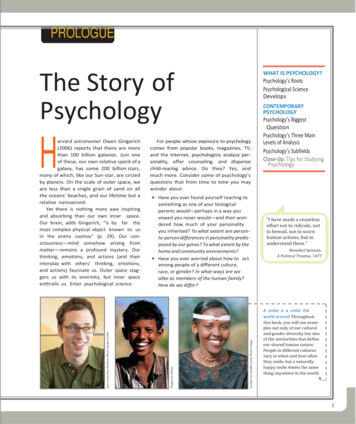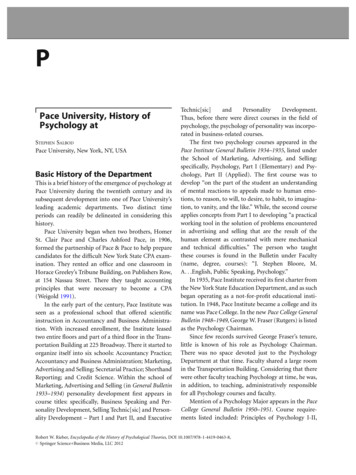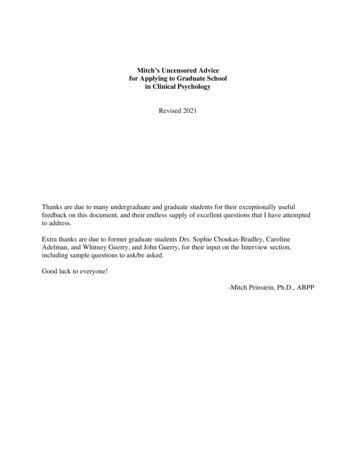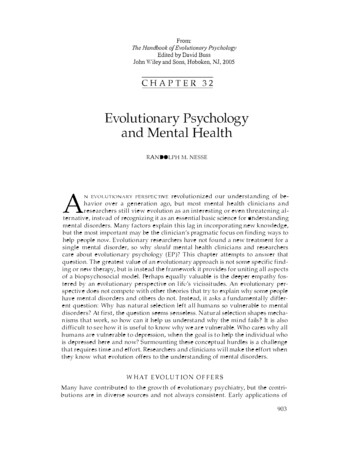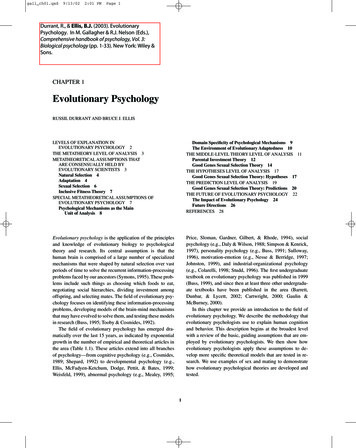
Transcription
gall ch01.qxd9/13/022:01 PMPage 1Durrant, R., & Ellis, B.J. (2003). EvolutionaryPsychology. In M. Gallagher & R.J. Nelson (Eds.),Comprehensive handbook of psychology, Vol. 3:Biological psychology (pp. 1-33). New York: Wiley &Sons.CHAPTER 1Evolutionary PsychologyRUSSIL DURRANT AND BRUCE J. ELLISLEVELS OF EXPLANATION INEVOLUTIONARY PSYCHOLOGY 2THE METATHEORY LEVEL OF ANALYSIS 3METATHEORETICAL ASSUMPTIONS THATARE CONSENSUALLY HELD BYEVOLUTIONARY SCIENTISTS 3Natural Selection 4Adaptation 4Sexual Selection 6Inclusive Fitness Theory 7SPECIAL METATHEORETICAL ASSUMPTIONS OFEVOLUTIONARY PSYCHOLOGY 7Psychological Mechanisms as the MainUnit of Analysis 8Domain Specificity of Psychological Mechanisms 9The Environment of Evolutionary Adaptedness 10THE MIDDLE-LEVEL THEORY LEVEL OF ANALYSIS 11Parental Investment Theory 12Good Genes Sexual Selection Theory 14THE HYPOTHESES LEVEL OF ANALYSIS 17Good Genes Sexual Selection Theory: Hypotheses 17THE PREDICTION LEVEL OF ANALYSIS 19Good Genes Sexual Selection Theory: Predictions 20THE FUTURE OF EVOLUTIONARY PSYCHOLOGY 22The Impact of Evolutionary Psychology 24Future Directions 26REFERENCES 28Evolutionary psychology is the application of the principlesand knowledge of evolutionary biology to psychologicaltheory and research. Its central assumption is that thehuman brain is comprised of a large number of specializedmechanisms that were shaped by natural selection over vastperiods of time to solve the recurrent information-processingproblems faced by our ancestors (Symons, 1995). These problems include such things as choosing which foods to eat,negotiating social hierarchies, dividing investment amongoffspring, and selecting mates. The field of evolutionary psychology focuses on identifying these information-processingproblems, developing models of the brain-mind mechanismsthat may have evolved to solve them, and testing these modelsin research (Buss, 1995; Tooby & Cosmides, 1992).The field of evolutionary psychology has emerged dramatically over the last 15 years, as indicated by exponentialgrowth in the number of empirical and theoretical articles inthe area (Table 1.1). These articles extend into all branchesof psychology—from cognitive psychology (e.g., Cosmides,1989; Shepard, 1992) to developmental psychology (e.g.,Ellis, McFadyen-Ketchum, Dodge, Pettit, & Bates, 1999;Weisfeld, 1999), abnormal psychology (e.g., Mealey, 1995;Price, Sloman, Gardner, Gilbert, & Rhode, 1994), socialpsychology (e.g., Daly & Wilson, 1988; Simpson & Kenrick,1997), personality psychology (e.g., Buss, 1991; Sulloway,1996), motivation-emotion (e.g., Nesse & Berridge, 1997;Johnston, 1999), and industrial-organizational psychology(e.g., Colarelli, 1998; Studd, 1996). The first undergraduatetextbook on evolutionary psychology was published in 1999(Buss, 1999), and since then at least three other undergraduate textbooks have been published in the area (Barrett,Dunbar, & Lycett, 2002; Cartwright, 2000; Gaulin &McBurney, 2000).In this chapter we provide an introduction to the field ofevolutionary psychology. We describe the methodology thatevolutionary psychologists use to explain human cognitionand behavior. This description begins at the broadest levelwith a review of the basic, guiding assumptions that are employed by evolutionary psychologists. We then show howevolutionary psychologists apply these assumptions to develop more specific theoretical models that are tested in research. We use examples of sex and mating to demonstratehow evolutionary psychological theories are developed andtested.1
gall ch01.qxd29/13/022:01 PMPage 2Evolutionary PsychologyTABLE 1.1 Growth of Publications in the Area of EvolutionaryPsychology, as Indexed by the PsycINFO DatabaseNumber of PublicationsaYears of �2000425100231aNumber of articles, books, and dissertations in the PsycINFO database thatinclude either the phrase evolutionary psychology or evolutionary psychological in the title, in the abstract, or as a keyword. All articles from theJournal of Evolutionary Psychology, which is a psychoanalytic journal, wereexcluded.LEVELS OF EXPLANATION INEVOLUTIONARY PSYCHOLOGYWhy do siblings fight with each other for parental attention? Why are men more likely than women to kill sexualrivals? Why are women most likely to have extramarital sexwhen they are ovulating? To address such questions, evolutionary psychologists employ multiple levels of explanationranging from broad metatheoretical assumptions, to morespecific middle-level theories, to actual hypotheses andpredictions that are tested in research (Buss, 1995; Ketelaar &Ellis, 2000). These levels of explanation are ordered in ahierarchy (see Figure 1.1) and constitute the methodology thatevolutionary psychologists use to address questions abouthuman nature.At the top of the hierarchy are the basic metatheoreticalassumptions of modern evolutionary theory. This set of guiding assumptions, which together are referred to as evolutionary metatheory, provide the foundation that evolutionaryscientists use to build more specific theoretical models. Webegin by describing (a) the primary set of metatheoreticalassumptions that are consensually held by evolutionary scientists and (b) the special set of metatheoretical assumptionsthat distinguish evolutionary psychology. We use the termevolutionary psychological metatheory to refer inclusively tothis primary and special set of assumptions together.As shown in Figure 1.1, at the next level down in the hierarchy, just below evolutionary psychological metatheory, aremiddle-level evolutionary theories. These theories elaboratethe basic metatheoretical assumptions into a particular psychological domain such as mating or cooperation. In thischapter we consider two related middle-level evolutionarytheories—parental investment theory and good genes sexualEvolutionary Psychological MetatheoryBasic metatheoretical assumptions of modern evolutionary theory.Special metatheoretical assumptions of evolutionary psychology.Middle-Level TheoriesAttachment theory(Bowlby, 1969)Good genes sexual selectiontheoryParental investment theory(Trivers, 1972)HypothesesIndividuals who more fullydisplay traits indicative of highgenetic quality should behealthier and in better conditionthan should conspecifics whodisplay these traits less fully.Males who display indicators ofhigh genetic quality shouldhave more sexual partnersand more offspring.The frequency and timing offemale orgasm should varyin a manner that selectivelyfavors the sperm of maleswho display indicators ofhigh genetic quality.Specific PredictionsMore symmetrical individualsshould have better mental andphysical health, better immunesystem functioning, and lowerparasite loads than should lesssymmetrical individuals.Figure 1.1More symmetrical men shouldhave more lifetime sexualpartners and more extrapairsexual partners than shouldless symmetrical men.The timing and frequency oforgasms by women should bepatterned to selectively retainthe sperm of moresymmetrical men.The hierarchical structure of evolutionary psychological explanations (adapted from Buss, 1995).
gall ch01.qxd9/13/022:01 PMPage 3Metatheoretical Assumptions That Are Consensually Held by Evolutionary Scientistsselection theory—each of which applies the assumptions ofevolutionary psychological metatheory to the question ofreproductive strategies. In different ways these middle-leveltheories attempt to explain differences between the sexes aswell as variation within each sex in physical and psychological adaptations for mating and parenting.At the next level down are the actual hypotheses and predictions that are drawn from middle-level evolutionary theories (Figure 1.1). A hypothesis is a general statement aboutthe state of the world that one would expect to observe if thetheory from which it was generated were in fact true. Predictions are explicit, testable instantiations of hypotheses. Weconclude this chapter with an evaluation of hypotheses andspecific predictions about sexual behavior that have been derived from good genes sexual selection theory. Special attention is paid to comparison of human and nonhuman animalliteratures.THE METATHEORY LEVEL OF ANALYSISScientists typically rely on basic (although usually implicit)metatheoretical assumptions when they construct and evaluate theories. Evolutionary psychologists have often called onbehavioral scientists to make explicit their basic assumptionsabout the origins and structure of the mind (see Gigerenzer,1998). Metatheoretical assumptions shape how scientistsgenerate, develop, and test middle-level theories and their derivative hypotheses and predictions (Ketelaar & Ellis, 2000).These basic assumptions are often not directly tested afterthey have been empirically established. Instead they are usedas a starting point for further theory and research. Newton’slaws of motion form the metatheory for classical mechanics,the principles of gradualism and plate tectonics provide ametatheory for geology, and the principles of adaptationthrough natural selection provide a metatheory for biology.Several scholars (e.g., Bjorklund, 1997; Richters, 1997) haveargued that the greatest impediment to psychology’s development as a science is the absence of a coherent, agreed-uponmetatheory.A metatheory operates like a map of a challenging conceptual terrain. It specifies both the landmarks and the boundaries of that terrain, suggesting which features are consistentand which are inconsistent with the core logic of the metatheory. In this way a metatheory provides a set of powerfulmethodological heuristics: “Some tell us what paths to avoid(negative heuristic), and others what paths to pursue (positiveheuristic)” (Lakatos, 1970, p. 47). In the hands of a skilled researcher, a metatheory “provides a guide and prevents certainkinds of errors, raises suspicions of certain explanations or3observations, suggests lines of research to be followed, andprovides a sound criterion for recognizing significant observations on natural phenomena” (Lloyd, 1979, p. 18). Theultimate contribution of a metatheory is that it synthesizesmiddle-level theories, allowing the empirical results of avariety of different theory-driven research programs to beexplicated within a broader metatheoretical framework. Thisfacilitates systematic cumulation of knowledge and progression toward a coherent big picture, so to speak, of the subjectmatter (Ketelaar & Ellis, 2000).METATHEORETICAL ASSUMPTIONS THATARE CONSENSUALLY HELD BYEVOLUTIONARY SCIENTISTSWhen asked what his study of the natural world had revealedabout the nature of God, biologist J. B. S. Haldane is reportedto have made this reply: “That he has an inordinate fondnessfor beetles.” Haldane’s retort refers to the extraordinary diversity of beetle species found throughout the world—some290,000 species have so far been discovered (E. O. Wilson,1992). Beetles, moreover, come in a bewildering variety ofshapes and sizes, from tiny glittering scarab beetles barelyvisible to the naked eye to ponderous stag beetles with massive mandibles half the size of their bodies. Some beetlesmake a living foraging on lichen and fungi; others subsist ona diet of beetles themselves.The richness and diversity of beetle species are mirroredthroughout the biological world. Biologists estimate thatanywhere from 10 to 100 million different species currentlyinhabit the Earth (E. O. Wilson, 1992), each one in somerespect different from all others. How are we to explain thisextraordinary richness of life? Why are there so many speciesand why do they have the particular characteristics that theydo? The general principles of genetical evolution drawn frommodern evolutionary theory, as outlined by W. D. Hamilton(1964) and instantiated in more contemporary so-called selfish gene theories of genetic evolution via natural and sexualselection, provide a set of core metatheoretical assumptionsfor answering these questions. Inclusive fitness theory conceptualizes genes or individuals as the units of selection (seeDawkins, 1976; Hamilton, 1964; Williams, 1966). In contrast, “multilevel selection theory” is based on the premisethat natural selection is a hierarchical process that can operate at many levels, including genes, individuals, groupswithin species, or even multi-species ecosystems. Thus, multilevel selection theory is conceptualized as an elaboration ofinclusive fitness theory (adding the concept of group-leveladaptation) rather than an alternative to it (D. S. Wilson &
gall ch01.qxd49/13/022:01 PMPage 4Evolutionary PsychologySober, 1994). Whereas inclusive fitness theory is consensually accepted among evolutionary scientists, multilevel selection theory is not. Thus, this review of basic metatheoreticalassumptions only focuses on inclusive fitness theory.Natural SelectionDuring his journey around the coastline of South Americaaboard the HMS Beagle, Charles Darwin was intrigued by thesheer diversity of animal and plant species found in the tropics,by the way that similar species were grouped together geographically, and by their apparent fit to local ecological conditions. Although the idea of biological evolution had beenaround for some time, what had been missing was an explanation of how evolution occurred—that is, what had been missing was an account of the mechanisms responsible forevolutionary change. Darwin’s mechanism, which he labelednatural selection, served to explain many of the puzzling factsabout the biological world: Why were there so many species?Why are current species so apparently similar in manyrespects both to each other and to extinct species? Why doorganisms have the specific characteristics that they do?The idea of natural selection is both elegant and simple,and can be neatly encapsulated as the result of the operationof three general principles: (a) phenotypic variation, (b) differential fitness, and (c) heritability.As is readily apparent when we look around the biologicalworld, organisms of the same species vary in the characteristics that they possess; that is, they have slightly differentphenotypes. A whole branch of psychology—personality andindividual differences—is devoted to documenting and understanding the nature of these kinds of differences in ourown species. Some of these differences found among members of a given species will result in differences in fitness—that is, some members of the species will be more likely tosurvive and reproduce than will others as a result of the specific characteristics that they possess. For evolution to occur,however, these individual differences must be heritable—that is, they must be reliably passed on (via shared genes)from parents to their offspring. Over time, the characteristicsof a population of organisms will change as heritable traitsthat enhance fitness will become more prevalent at theexpense of less favorable variations.For example, consider the evolution of bipedalism inhumans. Paleoanthropological evidence suggests that uprightwalking (at least some of the time) was a feature of early hominids from about 3.5 million years ago (Lovejoy, 1988). Presume that there was considerable variation in the propensity towalk upright in the ancestors of this early hominid species asthe result of differences in skeletal structures, relevant neuralprograms, and behavioral proclivities. Some hominids did andsome did not. Also presume that walking on two feet much ofthe time conferred some advantage in terms of survival and reproductive success. Perhaps, by freeing the hands, bipedalismallowed objects such as meat to be carried long distances (e.g.,Lovejoy, 1981). Perhaps it also served to cool the body by reducing the amount of surface area exposed to the harsh tropical sun, enabling foraging throughout the hottest parts of theday (e.g., Wheeler, 1991). Finally, presume that these differences in the propensity for upright walking were heritable innature—they were the result of specific genes that were reliably passed on from parents to offspring. The individuals whotended to walk upright would be, on average, more likely tosurvive (and hence, to reproduce) than would those who didnot. Over time the genes responsible for bipedalism would become more prevalent in the population as the individuals whopossessed them were more reproductively successful thanwere those who did not, and bipedalism itself would becomepervasive in the population.Several points are important to note here. First, naturalselection shapes not only the physical characteristics oforganisms, but also their behavioral and cognitive traits.The shift to bipedalism was not simply a matter of changesin the anatomy of early hominids; it was also the result ofchanges in behavioral proclivities and in the complex neuralprograms dedicated to the balance and coordination requiredfor upright walking. Second, although the idea of naturalselection is sometimes encapsulated in the slogan the survival of the fittest, ultimately it is reproductive fitness thatcounts. It doesn’t matter how well an organism is able tosurvive. If it fails to pass on its genes, then it is an evolutionary dead end, and the traits responsible for its enhancedsurvival abilities will not be represented in subsequent generations. This point is somewhat gruesomely illustrated bymany spider species in which the male serves as both mealand mate to the female—often at the same time. Ultimately,although one must survive to reproduce, reproductive goalstake precedence.AdaptationNatural selection is the primary process which is responsible for evolutionary change over times as more favorablevariants are retained and less favorable ones are rejected(Darwin, 1859). Through this filtering process, natural selection produces small incremental modifications in existingphenotypes, leading to an accumulation of characteristicsthat are organized to enhance survival and reproductive success. These characteristics that are produced by natural selection are termed adaptations. Adaptations are inherited and
gall ch01.qxd9/13/022:01 PMPage 5Metatheoretical Assumptions That Are Consensually Held by Evolutionary Scientistsreliably developing characteristics of species that have beenselected for because of their causal role in enhancing thesurvival and reproductive success of the individuals thatpossess them (see Buss, Haselton, Shackelford, Bleske, &Wakefield, 1998; Dawkins, 1986; Sterelny & Griffiths, 1999;Williams, 1966, 1992, for definitions of adaptation).Adaptations have biological functions. The immune system functions to protect organisms from microbial invasion,the heart functions as a blood pump, and the cryptic coloringof many insects has the function of preventing their detectionby predators. The core idea of evolutionary psychology isthat many psychological characteristics are adaptations—justas many physical characteristics are—and that the principlesof evolutionary biology that are used to explain our bodiesare equally applicable to our minds. Thus, various evolutionary psychological research programs have investigated psychological mechanisms—for mate selection, fear of snakes,face recognition, natural language, sexual jealousy, and soon—as biological adaptations that were selected for becauseof the role they played in promoting reproductive success inancestral environments.It is worth noting, however, that natural selection is notthe only causal process responsible for evolutionary change(e.g., Gould & Lewontin, 1979). Traits may also becomefixated in a population by the process of genetic drift,whereby neutral or even deleterious characteristics becomemore prevalent due to chance factors. This may occur insmall populations because the fittest individuals may turnout—due to random events—not to be the ones with thegreatest reproductive success. It does not matter how fit youare if you drown in a flood before you get a chance to reproduce. Moreover, some traits may become fixated in apopulation not because they enhance reproductive success,but because they are genetically or developmentally yokedto adaptations that do. For example, the modified wrist boneof the panda (its “thumb”) seems to be an adaptation for manipulating bamboo, but the genes responsible for this adaptation also direct the enlarged growth of the correspondingbone in the panda’s foot, a feature that serves no function atall (Gould, 1980).There is much debate among evolutionary biologists andphilosophers of biology regarding the relative importance ofdifferent evolutionary processes (see Sterelny & Griffiths,1999, for a good introduction to these and other issues inthe philosophy of biology). The details of these disputes,however, need not concern us here. What is important tonote is that not all of the products of evolution will be biological adaptations with evolved functions. The evolutionaryprocess also results in by-products of adaptations, as well asa residue of noise (Buss et al., 1998; Tooby & Cosmides,51992). Examples of by-products are legion. The sound thathearts make when they beat, the white color of bones, andthe human chin are all nonfunctional by-products of naturalselection. In addition, random variation in traits—as long asthis variation is selectively neutral (neither enhancing nor reducing biological fitness)—can also be maintained as residual noise in organisms.Demarcating the different products of evolution is anespecially important task for evolutionary psychologists. Ithas often been suggested that many of the important phenomena that psychologists study—for example, reading, writing,religion—are by-products of adaptations rather than adaptations themselves (e.g., Gould, 1991a). Of course, even byproducts can be furnished with evolutionary explanationsin terms of the adaptations to which they are connected(Tooby & Cosmides, 1992). Thus, for example, the whitenessof bones is a by-product of the color of calcium salts, whichgive bones their hardness and rigidity; the chin is a byproduct of two growth fields; and reading and writing areby-products (in part) of the evolved mechanisms underlyinghuman language (Pinker, 1994).The important question is how to distinguish adaptationsfrom nonadaptations in the biological world. Because we cannot reverse time and observe natural selection shaping adaptations, we must make inferences about evolutionary historybased on the nature of the traits we see today. A variety ofmethods can (and should) be employed to identify adaptations(see M. R. Rose & Lauder, 1996). Evolutionary psychologists,drawing on the work of George Williams (1966), typicallyemphasize the importance of special design features suchas economy, efficiency, complexity, precision, specialization,reliability, and functionality for identifying adaptations (e.g.,Buss et al., 1998; Pinker, 1997; Tooby & Cosmides, 1990).One hallmark that a trait is the product of natural selection isthat it demonstrates adaptive complexity—that is, the traitis composed of a number of interrelated parts or systems thatoperate in concert to generate effects that serve specific functions (Dawkins, 1986; Pinker, 1997).Echolocation in bats is a good example of such a trait. Acollection of interrelated mechanisms allows foraging bats tomaneuver around obstacles in complete darkness and to pickout small rapidly moving prey on the wing. Echolocating batshave a number of specialized mechanisms that precisely, reliably, and efficiently enable them to achieve the function ofnocturnal locomotion and foraging. Bats have mechanismsthat allow them to produce rapid, high-frequency, shortwavelength cries that are reflected by small objects. Moreover, the frequency and rapidity of these cries are modifieddepending on the distance of the object being detected (lowfrequency waves penetrate further but can only be used to
gall ch01.qxd69/13/022:01 PMPage 6Evolutionary Psychologydetect large objects). Bats also have specialized mechanismsthat protect their ears while they are emitting loud sounds,and their faces are shaped to enhance the detection of theirreturning echoes. It is extraordinary unlikely that such acomplex array of intertwining processes could have arisen bychance or as a by-product of evolutionary processes. Thus,one has clear warrant in this case to assert that echolocationin bats is a biological adaptation.Many traits, however, may not be so clearly identifiable asadaptations. Furthermore, there are often disputes about justwhat function some trait has evolved to serve, even if one canbe reasonably sure that it is the product of natural selection.In adjudicating between alternative evolutionary hypotheses,one can follow the same sort of strategies that are employedwhen comparing alternative explanations in any domain inscience—that is, one should favor the theory or hypothesisthat best explains the evidence at hand (Haig & Durrant,2000; Holcomb, 1998) and that generates novel hypothesesthat lead to new knowledge (Ketelaar & Ellis, 2000).Consider, for example, the alternative explanations thathave been offered for the origin of orgasm in human females. Female orgasm serves no evolved function and is a byproduct of selection on male orgasm, which is necessaryfor fertilization to occur (Gould, 1991b, pp. 124–129;Symons, 1979). Orgasm is an adaptation that promotes pair-bonding in thehuman species (Eibl-Eibesfeldt, 1989). Female orgasm is an adaptation that motivates females toseek multiple sexual partners, confusing males about paternity and thus reducing the probability of subsequentmale infanticide (Hrdy, 1981). Female orgasm is an adaptation that serves to enhancesperm retention, therefore allowing females to exert somecontrol over the paternity of their offspring via differentialpatterns of orgasm with specific male partners, especiallythose of high genetic quality (Baker & Bellis, 1993;Smith, 1984).Although all of these models have some plausibility, it is thelast suggestion that is beginning to be accepted as the bestcurrent explanation. Baker and Bellis (1993) have demonstrated that females retain more sperm if they experiencecopulatory orgasms up to 45 min after—or at the sametime as—their male partners. Thus, depending on their timing,orgasms appear to enhance the retention of sperm via the “upsuck” from the vagina into the cervix. The selective sperm retention model predicts that women will experience moreorgasms—and specifically, more high-sperm-retentionorgasms—with men who have specific indicators of geneticquality. This prediction has been supported in research on dating and married couples (Thornhill, Gangestad, & Comer,1995). Moreover, the occurrence of high sperm retention orgasms are a significant predictor of a desire for pregnancy inwomen, suggesting that female orgasms are one mechanismfor increasing the likelihood of conception (Singh, Meyer,Zambarano, & Hurlbert, 1998).Although there are a number of theories of extrapair mating in human females (mating that occurs outside of a current, ongoing relationship), one prominent suggestion is thatextrapair mating has evolved to enhance reproductive success by increasing selective mating with males who demonstrate high genetic quality (e.g., Gangestad, 1993; Greiling &Buss, 2000). In support of this idea, men who possess indicators of high genetic quality (as assessed by degree of symmetry of bilateral physical traits) are more likely to be chosenby women specifically as extrapair sex partners but not aspartners in long-term relationships (Gangestad & Simpson,2000). Further, Bellis and Baker (1990) found that womenwere most likely to copulate with extrapair partners but notwith in-pair partners during the fertile phase of their menstrual cycles. Finally, as a result of the type and frequency oforgasms experienced by women, it appears that levels ofsperm retention are significantly higher during extrapaircopulations than during copulations with in-pair partners(Baker & Bellis, 1995).In summary, although more research needs to be done, ourbest current explanation for the human female orgasm is thatit is an adaptation specifically, precisely, and efficiently designed to manipulate the paternity of offspring by favoring thesperm of males of high genetic quality. This model (a) concurswith what is known about female orgasm; (b) generatedspecific, testable predictions about patterns of variation in female orgasm that were as yet unobserved and were not forecast by competing models; (c) generated interesting new linesof research on female orgasm that provided support for thepredictions; and (d) led to acquisition of new knowledgeabout the timing and probability of female orgasm withdifferent partners.Sexual SelectionNot all adaptations can be conceptualized as adaptations forsurvival per se. Although the bat’s complex system of echolocation enables it to navigate and forage in darkness, thehuman female orgasm has no such obvious utilitarian function. As Darwin (1871) clearly recognized, many of the interesting features that plants and animals possess, such as thegaudy plumage and elaborate songs of many male birds, serveno obvious survival functions. In fact, if anything, such traits
gall ch01.qxd9/13/022:01 PMPage 7Special Metatheoretical Assumptions of Evolutionary Psychologyare likely to reduce survival prospects by attracting predators,impeding movement, and so on. Darwin’s explanation forsuch characteristics was that they were the product of aprocess that he labeled sexual selection. This kind of selectionarises not from a struggle to survive, but rather from the competition that arises over mates and mating (Andersson, 1994;Andersson & Iwasa, 1996). If—for whatever reason—havingelongated tail feathers or neon blue breast plumage enablesone to attract more mates, then such traits will increase reproductive success. Moreover, to the extent that such traits arealso heritable, they will be likely to spread in the population,even if they might diminish s
textbook on evolutionary psychology was published in 1999 (Buss, 1999), and since then at least three other undergradu-ate textbooks have been published in the area (Barrett, Dunbar, & Lycett, 2002; Cartwright, 2000; Gaulin & . Although t

